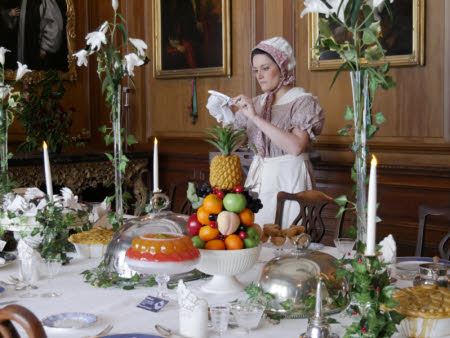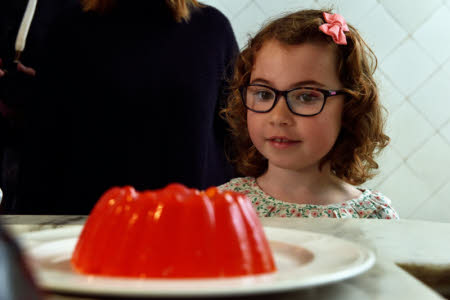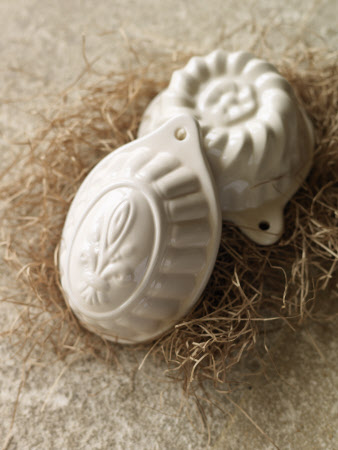Cooks have been setting liquids with gelatin, isinglass, and hartshorn since the Middle Ages. These early jellies sometimes contained meat, were often highly spiced, and sometimes sweetened and flavored with rose-water.
They were the ancestors not only of sweet jellies but also of the vegetable, fish and meat terrines and mousses still made today. Dessert jellies often contain fruit but this is very different. Jellies made with wine or port were very popular with the Victorians.
A similar type of preparation is a summer pudding. Mixing the fruit with bread makes them firmer and easier to turn out.

Regency Christmas featuring jelly and fruit mold at Lyme Park, Cheshire ©National Trust/Mike King
Claret Jelly
Serves 6
Ingredients

Young visitor exploring the Victorian kitchen at Lanhydrock, Cornwall. ©National Trust Images/John Millar
- 600 ml (1 pint) claret
- Zest and juice of 1 lemon
- 15-30g (1/2 – 1 oz) powdered gelatin
- 75 – 110 g (3-4 oz) sugar
For decoration
- Black grapes
- Egg white
- Caster sugar
Method
- Place 4 tablespoons of the claret and the lemon juice in a small basin and stir in the gelatin. If you wish to serve your wine jelly in glasses, 15g (1/2 oz) of gelatin will be sufficient, but if you wish to turn it out of a fancy mould, add an extra 15g (1/2 oz) to make certain, but do check quantities on the packet, because different brands can vary in strength.
- Leave for 5 minutes until swollen and soft, then stir this into half the remaining claret in a pan.
Add sugar and lemon zest, then bring slowly almost, but not quite, to the boil, stirring all the time. - Strain into a bowl and gently stir in the remaining claret. Pour in glasses, a wetted mould, or a pretty bowl and leave it to set in a cool place.
- Serve slightly chilled. Decorate with small bunches of black grapes which have been frosted with with egg white and caster sugar. A little thin cream poured on top of the jelly is a perfect accompaniment.

Summer Fruit Moulds

Traditional jelly moulds ©National Trust Images/Crisitian Barnett
Makes 6 ramekins
Ingredients:
- 900g (2 lb) prepared soft fruit like blackcurrants and red currants, stripped from their stems; strawberries, blackberries, raspberries, gooseberries, topped and tailed.
- 12 thick slices of milk loaf
- 600 ml (1 pint) water
- Sugar
- 4 tablespoons cassis or elderflower cordial
To decorate:
- Extra fruit
- Fresh mint or lemon balm sprigs
Method:
-
- First put a piece of baking paper, cut to size, in the base of each ramekin. This will make them easier to turn out.
- Try to use at least two varieties of soft fruit. Cut the crusts off the bread and cut the slices into large dice. Put the fruit in a pan, cover with the water and simmer until fruit is tender.
- Gooseberries and blackcurrants need 5 minutes or so; strawberries, blackberries, and raspberries just need to be brought up to the boil and then removed from the heat immediately. Remove the fruit from the juice with a slotted spoon and add sufficient sugar to the juice to make a syrup. This will vary according to the fruits and taste.
- Bring the syrup to the boil and simmer for 5 minutes. Allow to cool and add the cassis or elderflower cordial.
- Mix the fruit and bread together. Put a little syrup in the bottom of each ramekin, then pack in the fruit and bread, pressing the mixture down well. Spoon a little syrup over the top of each ramekin. Chill until ready to eat.
To serve, run a knife around the inside of each ramekin and unmould onto a dessert plate. Take off the paper and pour over the rest of the juice and then decorate with more fresh fruit and fresh mint or lemon balm sprigs.




